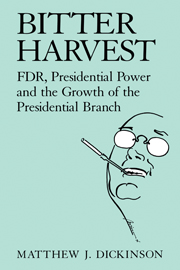Book contents
- Frontmatter
- Contents
- Preface and acknowledgments
- Introduction: The fruits of his labor? FDR and the growth of the presidential branch
- Part I Concepts and controversies
- Part II From cabinet to presidential government, 1933–9
- Part III Testing Roosevelt's staff system: The war years, 1939–45
- 4 Economic mobilization and World War II
- 5 Managing war production
- 6 FDR and the national security bureaucracy
- 7 The commander in chief
- Part IV Lessons and considerations
- References
- Indexes
7 - The commander in chief
Published online by Cambridge University Press: 21 January 2010
- Frontmatter
- Contents
- Preface and acknowledgments
- Introduction: The fruits of his labor? FDR and the growth of the presidential branch
- Part I Concepts and controversies
- Part II From cabinet to presidential government, 1933–9
- Part III Testing Roosevelt's staff system: The war years, 1939–45
- 4 Economic mobilization and World War II
- 5 Managing war production
- 6 FDR and the national security bureaucracy
- 7 The commander in chief
- Part IV Lessons and considerations
- References
- Indexes
Summary
America's entrance into the war relieved the isolationist pressure which FDR had found so constraining. But it also greatly multiplied his administrative burden. First, he had to construct a staff structure by which to exercise his military duties as commander in chief. Moreover, as part of a multination military coalition, he also had to devise means for integrating command of the American and British military forces, as well as those of other Allies, without violating norms of national sovereignty. How he did so, and what lessons are offered for contemporary presidents, is this chapter's subject.
Creating the Joint Chiefs of Staff (JCS)
The December 1941 conference with Churchill regarding U.S.-British military collaboration first demonstrated to FDR his need for a military command structure. The British Prime Minister arrived in Washington, D.C., with his Chiefs of Staff Committee in tow, comprised of the heads of the three British military services: the Army's Chief of the Imperial General Staff, the Navy's First Sea Lord, and the Chief of the Air Staff. Roosevelt, in contrast, had no comparable military staff; the Joint Army–Navy Board was primarily a planning tool, not an instrument of military command.
This lack of an American military staff proved problematic when the Allies tried to fashion an integrated command structure in order to respond to Japanese aggression in the south Pacific “ABDA” area (the area of strategic interest to Americans, British, Dutch, and the Australians). After some debate the British and Americans agreed generally on the principle of unity of command in each military theater; all joint military forces would be commanded by the nation whose interests were predominantly at stake in the affected region.
- Type
- Chapter
- Information
- Bitter HarvestFDR, Presidential Power and the Growth of the Presidential Branch, pp. 183 - 204Publisher: Cambridge University PressPrint publication year: 1996



